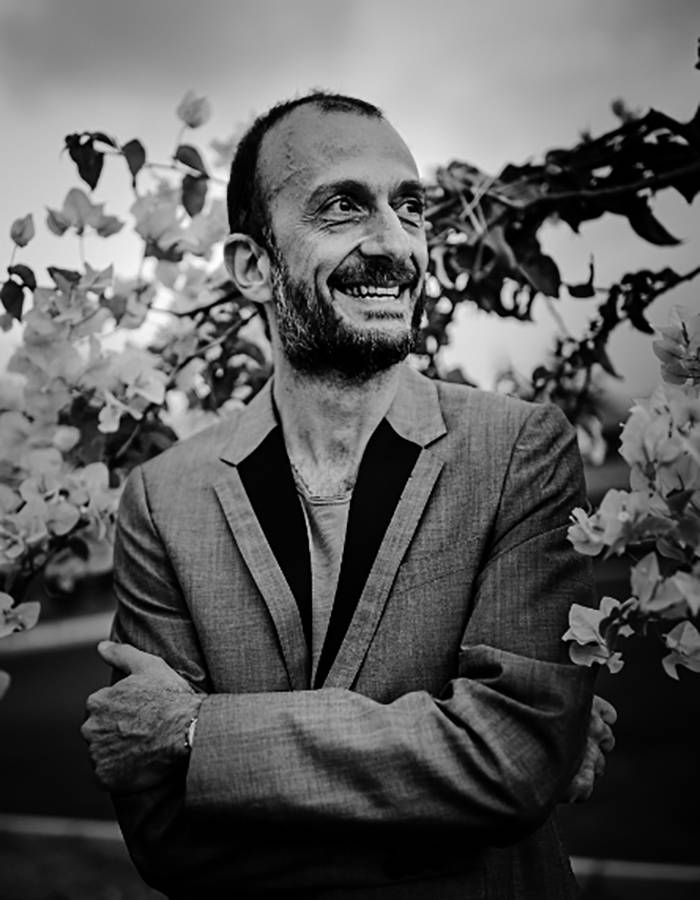
Gregory Buchakjian is an art historian and interdisciplinary visual artist. He lives and works in Beirut where he was born in 1971.
PhD graduate at Sorbonne Université, he is director of the School of Visual Arts and Associate Professor at Académie Libanaise des Beaux-Arts (ALBA).
Buchakjian's practice is based on narrative, archive and archeology. Investigating on urban turmoil, dereliction and heritage engendered his PhD dissertation, the subsequent book, Abandoned Dwellings, A History of Beirut (Beirut, Kaph Books: 2018, Valerie Cachard, ed.) and the solo exhibitions Abandoned Dwellings, Display of Systems (Beirut, Sursock Museum, 2018 curated by Karina El Helou and Abandoned Dwellings of Beirut (Brussels, Villa Empain, 2019).
In 2018, he was showcased in the first national pavilion of Lebanon at the Venice Architecture Biennale and he contributed to the Works on Paper accompanying Karina El Helou's Cycles of Collapsing Progress exhibition in Oscar Nimeyer's Tripoli International Fair. In 2019 he conceived the installation Where do filmmakers go? for the 2nd Alba Cinema encounters, "Filming in Times of War", which he co-organized. In 2021, he created with Valérie Cachard and Sary Moussa the video Agenda 1979 at the invitation of the Opera National du Rhin, and the installation Hercules and Omphale for the exhibition How will it end? (Villa Empain, Brussels, in partnership with Centre Pompidou), based on a painting that was damaged by the blast of the 4th of August 2020 he attributed to Artemisia Gentileschi.
In 2022, he premiered at Fotofocus Biennial Cincinnati his long-term Record of an Ordinary Life and intervened with Temporary art Platform in the Roman Temple of Hosn Niha. Member of the advisory committee of the Saradar Collection, he took part in many juries including Sursock Museum Salon d'Automne (2009), Boghossian Prize (2012), Beirut Art Center's Exposure (2013), Beirut Art Residency (2017) and Arab Documentary Photography Program (2019).
Biographie:
Artiste transdisciplinaire et historien d’art, Gregory Buchakjian est professeur associé et directeur de l'École des arts visuels à l’Académie libanaise des beaux-arts – Alba, Université de Balamand.
Basée sur l’archive, l’archéologie et le récit, sa démarche prend forme dans une thèse de doctorat, l’ouvrage Habitats abandonnés, une histoire de Beyrouth (Beyrouth, Kaph Books, 2018) et les expositions monographiques sur le même sujet au Musée Sursock (2018) et la Villa Empain, Bruxelles (2019).
En 2018, il a également contribué au premier pavillon libanais à la Biennale d’architecture de Venise.
En 2021, à l’invitation de l’Opéra national du Rhin, il a créé la vidéo Agenda 1979 avec Valérie Cachard, puis l’installation Hercule et Omphale pour l’exposition How will it end? (Villa Empain, Bruxelles, en partenariat avec le Centre Pompidou) à partir d’une peinture ravagée par l’explosion du 4 août 2020 qu’il a attribué à Artemisia Gentileschi.
En 2022 il a entrepris le projet autobiographique Record of an Ordinary Life (Fotofocus Biennial Cincinnati) et l’action HN51 [48 Circles] 2022 dans le temple romain de Hosn Niha avec Temporary Art Platform. Membre du comité consultatif de la Saradar Collection, il a pris part à de nombreux jurys dont le Salon d’Automne du musée Sursock (2009), le Prix Boghossian (2012), Exposure (Beirut Art Center,2013), Beirut Art Residency (2017) et Arab Documentary Photography Program (2019).